The Classical Free-Reed, Inc.
History of the Free-Reed Instruments in Classical
Music |
|
Part Two: The Japanese shō |
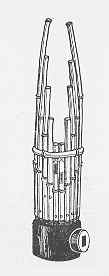
| Illustration 10: Sho.
Image from William P. Malm, Japanese Music and Musical
Instruments,
(Rutland, Vermont: Charles E. Tuttle Company, 1959),
99. |
The sho (or shou) is the Japanese equivalent of the Chinese shêng. Although the
standard sho has seventeen pipes and fifteen reeds, there have been
several varieties of the sho at different periods, varying chiefly in the
number of reeds. One is mentioned as having had thirty-six, and others
with twenty-six, nineteen, and thirteen respectively. The sho is perhaps
best known for its use in the Gagaku orchestra, where its principal
function is harmonic.
Gagaku — meaning literally noble or elegant music —
(End note 11)
was founded in 703
A.D. and, as such, is the world's oldest extant music and dance performing
institution. It flowered during the four centuries of the Heian Period (the time between the succession of Emperor
Kanmu in 781, to the beginning of the Kamakura bakufu — samurai government — in 1192), and since that time its
tradition, imperial support,
hereditary personnel and artistic repertory have continued without
interruption. Gagaku is not theatrical dance and music for a popular
audience; it is designed to be performed at a court or shrine, for a
philosophic, moral or religious purpose; for the inthronization of
emperors, for the marriage of crown princes, for the completion of
temples, for the gathering of the first rice.
Gagaku was introduced into Japan by Chinese and Korean musicians in the seventh century. Since its appearance in Japan,
it has been associated with the ceremonies and entertainment of the Imperial Court and its playing tradition has remain
relatively unchanged since 1150 A.D. There is no conductor; the concert master — Gakucho — plays a small
drum (Kakko or Sannnotuzumi) and leads the performance. The Choushi or Awase introduction — musical
passages to confirm the scale for the musical selections which follow — is played first. Each instrument enters in a
particular order: Choushi begins with the sho and Awase begins with a fue.
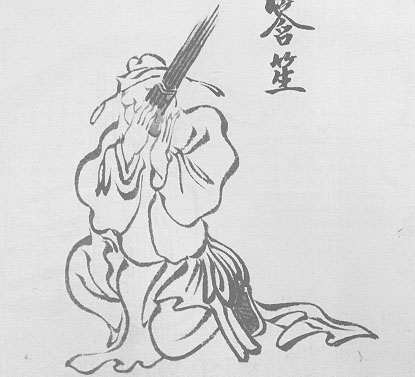
|
Illustration 11: Sho player performing court banquet music in the T'ang style. (From the Shinzei Kogakuzu).
Image from Robert Garfias, Music of a Thousand Autumns: The Togaku
Style of Japanese Court Music, (Berkeley: University of California
Press, 1975)
To see a
close up view of this image Click Here (117 KB)
|
Robert Garfias wrote about the image at left: "The present Gagaku tradition demands that sho
players hold their instruments with the pipes straight up. The Shinzei
Kogaku Zu illustration depicts either an older Asia mainland style of
playing or simply the artist's fancy."
The present-day Gagaku musicians and dancers are the direct descendants of
the court musicians of the Heian period and many trace their lineage back
for more than one thousand years. These musicians have undergone rigid
training since childhood to master their art; they can perform from modern
Western notation
(End note 12)
as well as from traditional Gagaku notation. The young
court musician completing his ten-year training period is required to have
memorized the entire Togaku repertoire, which numbers ninety-four
compositions. This does not include the netori, choshi, ranjo and special
Bugaku versions of compositions, as well as the entire Komagaku and Shinto
ceremonial repertoire.
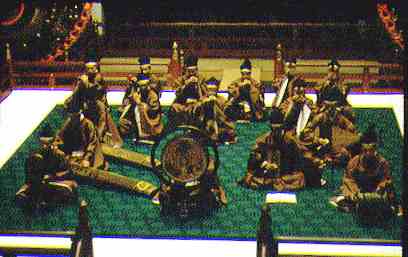
| Illustration 12: Gagaku orchestra.
The musicians of the Japanese Imperial Household Music Department performing Kangen, music with winds and strings,
on the dance stage of the Music Department in the palace.
Photo by Robert Garfias, ibid. |
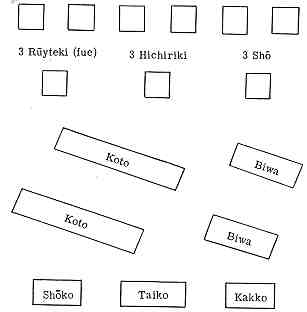
Illustration 13: Seating chart for Gagaku orchestra.
Image from Robert Garfias, ibid. 75.
3 Ruyteki (fue) [flutes], 3 Hichiriki [oboes], 3 Sho [mouth organs]
2
Koto [zithers], 2 Biwa [lutes]
1 Shoko [drum], 1 Taiko [gong], 1 Kakko
[barrel drum]
To see a
close up view of this image Click Here (8 KB)
|
Despite its relatively frozen playing style, Gagaku is not a dead art. New
dances are created today for contemporary occasions, such as the marriage
of Prince Akahito, the Imperial heir. Several Western composers, including
Igor Stravinsky, have shown an interest in Gagaku.
(End note 13)
The current leader of the Reigakusha Gagaku Ensemble, Sukeyasu Shiba, has composed
fifteen works for Gagaku Ensemble — ranging from three to fifty-five
minutes in length — which were recorded on the Columbia record label.
Three of his compositions are titled Hyobyo-no-hibiki I (1986),
Koku (1987) and Shotorashion (1990). He studied Gagaku
in the Gagaku Institute of the Imperial Household Agency. After working as
a court musician for over twenty years (playing the Yokobue), he
became an independent musician and began to disseminate Gagaku both inside
and outside Japan. Sukeyasu reconstructed ancient musical works and
received the Medal with a purple ribbon from the Japanese Government, the
Education Minister's Prize, as well as the Mobile Music Award.
He presently works as a guest professor at Kunitachi College of Music.
The traditional Japanese systems of music notation were types of
tablatures, as were early European systems. They either indicated a
string, a fingering position, or, in the case of the woodwinds, a hole or
fingering. Notation in Japan has always been primarily a supplement to
rote teaching methods and as such is often vague. Indeed, the tradition of
secret pieces and clan-owned music made such a system necessary, however
regrettable it may seem to the contemporary music researcher.
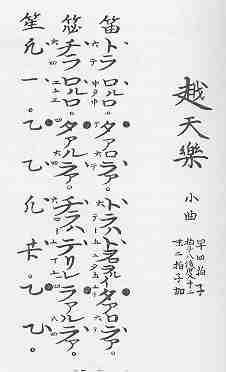
Example 7: Traditional Gagaku Notation.
Image from William P. Malm, op.cit. 264.
|
Example 7 shows the notation of the sho, the hichiriki and the ryuteki for
the beginning of the piece Etenraku. The column at the right is
the flute notation. The second column is the music for hichiriki. The
left-hand column is the notation for the sho. Each symbol represents the
bottom note of one of the eleven chords of the sho, or, in some cases, the
note itself. Rhythm is indicated by dots along the right-hand side of the
column plus white dots among the solfeggio for rests. The large dot
represents beat four or eight, depending on the meter of the composition.
As a rule, Gagaku music is not written in score as shown in example 7.
Instead, each musician has a separate part book. In fact, individual
musicians are sometimes unaware of what is going on in the other
instruments. This is an unfortunate consequence of rote teaching methods.

Example 8: The ten aitake.
Transcribed by Robert Garfias. op. cit. 48.
|
The sho players in the Gagaku orchestra most frequently play clusters of
tones, called aitake. Example 8 shows the ten aitake.
The instrument can be sounded either by inhalation or exhalation and the
player is expected to maintain a continuous stream of sound. The
distinctive mark of the professional sho player as opposed to the amateur
is the careful execution of the te-utsuri, the special
changing-patterns for moving from one aitake to another. Since
any one of the aitake may move to any one of nine others, there
are in all ninety possible combinations. The sho player must be familiar
with all the changes. Example 9 shows three examples of te-utsuri.
The effect of the patterns is to give a distinct character to the
connection of any two aitake.
(End note 14)

Example 9: Three examples of te-utsuri.
Transcribed by Robert Garfias. op. cit. 48.
|
The aitake harmonic structures are constructed on the basis of
consecutive fifths. In Gagaku (as in most Asian music) there is no concept
of harmonic progression as there is in Western music. Instead there is one
harmonic structure for each of the tones of the Togaku system.
Example 10, Bato (Yatara-Byoshi), is a transcription of a Togaku
composition. The placing of the various instrumental parts on the score
follows neither the standard Western system, which would place the strings
below the percussion parts, nor the usual Japanese order, which always
begins with the sho, after which come the hichiriki (oboe) and the fue.
The order used here, devised by Robert Garfias (University of California,
Irvine), divides the ensemble into three main instrumental functions: the
primary melody-playing instruments, the fue and hichiriki; the secondary
or supporting instruments: the sho, koto, and biwa (lute); and the
underlying rhythmic foundation supplied by the shoko, kakko, and taiko. In
the sho part, only the aitake have been given; the te-utsuri
patterns, produced by the various combinations of finger movements
when moving from one aitake to another, have been avoided because
they would add great confusion to the score and would overemphasize
subtleties of sho technique at the cost of melodic clarity.
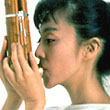
| Illustration 14: Mayumi Miyata
|
One of the foremost sho players today, Mayumi Miyata has premiered works
by John Cage, Toru Takemitsu, Klaus Huber, Maki Ishii and Gerhard Stäbler,
including the world premieres of Cage's work for sho and percussion,
Perugia (1992), Takemitsu's Ceremonial (1992) with the Saito
Kinen Orchestra under the direction of Seiji Ozawa, and Toshio Hosokawa's
Usurohi Nagi (1996) with the Cologne Radio Orchestra. She also
performed at the world premiere of Helmut Lachenmann's opera Das
Mädchen mit den Zündhölzern (1997) at the Hamburg State Opera. Mayumi
(as well as another virtuoso sho player, Ko Ishikawa) has performed with
the Reigakusha Gagaku Ensemble under the direction of Sukeyasu Shiba.
Mark Izu is another performer who specializes in Asian instruments,
including the shêng and the sho. He has studied and performed on the sho
with Japanese Imperial Court master musician, Suenobu Togi, since 1976, and
was the featured soloist for the West coast premiere of Somei Sato's
composition for sho, strings and percussion, Journey Through Sacred
Time, at the 1986 Cabrillo Music Festival. Izu is also a composer of
music for sho, including the live score to Sesue Hayakawaís 1919 film,
Dragon Painter. More recently Mr. Izu was commissioned by Asian
Improv aRts to write and perform a composition for a joint ensemble
featuring Western and Eastern instrumentation called Hibakusha,
Survivors!
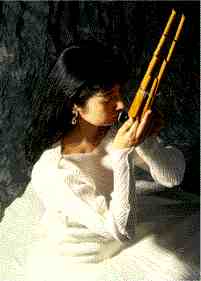
Illustration 15: Tamami Tono
Photo by Miro Ito
|
Tamami Tono is another Japanese sho player who is also a distinguished
composer. Her piece for sho and soprano won second prize in the
Sougakudoh Japanese Song Concours, and her works for sho and live
computer were accepted in ICMC98 (Intermational Computer Music Conference)
in the US — ISCM (International Society of Contemporary Music). As a sho
player, she has been playing at the National Theatre of Japan since 1990.
The German composer Gerhard Stä'bler has written for solo sho: Gagaku
— Zwei Stücke der japanischen Hofmusik für Sho (1998) and Palast
des Schweigens — Kassandra-Studie für Sho (1992-3), as well as
Karas. Krähen (1994-5) for sho, contrabass, percussion and tape.
The American composer, John Cage (1912-1992), wrote several pieces for
sho, including One9 (1991) for solo sho, Two3 (1991)
for sho and conch shell/percussion, Two4 (1991) for violin and
piano or sho, and Perugia (1992), for sho and percussion. These
pieces were composed during Cage's most abstract period; he titled
works simply with numbers which represented the number of players in
various ensemble configurations. Most of the works use his "time-bracket
notation" which permitted him to generate pieces rapidly and mechanically.
End Notes
11. Robert Garfias wrote, "Gagaku was introduced to Japan from China and Korea. The Word Gagaku is written
with two Chinese characters that mean "elegant music".
 The term is in fact a misnomer, not to imply that this music is not elegant, but only that the term, in Chinese, Ya-Yueh,
refers to the ancient music for the propitiation of the ancestral spirits and the ensuring of the continued balance of
the elements of nature. This was not the music introduced into Japan. The music that the Japanese imported into the
court during the 6th and 7th centuries, was of the type known as yen yueh, or engaku,
The term is in fact a misnomer, not to imply that this music is not elegant, but only that the term, in Chinese, Ya-Yueh,
refers to the ancient music for the propitiation of the ancestral spirits and the ensuring of the continued balance of
the elements of nature. This was not the music introduced into Japan. The music that the Japanese imported into the
court during the 6th and 7th centuries, was of the type known as yen yueh, or engaku,
 in Japanese, meaning court banquet music. Ya-yueh, proper, sometimes called Confucian Ceremonial music, was never
introduced into Japan, perhaps because the Japanese already had their own sacred ritual music, kagura, which was
associated with the way of the gods, or Shintoism. Nevertheless, the term, Gagaku, or ya-yueh in Chinese, was retained
by the Japanese perhaps because of the loftier associations carried by that word."
in Japanese, meaning court banquet music. Ya-yueh, proper, sometimes called Confucian Ceremonial music, was never
introduced into Japan, perhaps because the Japanese already had their own sacred ritual music, kagura, which was
associated with the way of the gods, or Shintoism. Nevertheless, the term, Gagaku, or ya-yueh in Chinese, was retained
by the Japanese perhaps because of the loftier associations carried by that word."
Robert Garfias.
12. For over one thousand years, the Gagaku musicians performed only Japanese music learned by rote.
In 1872 a crisis occurred: the Imperial Family decided that Japan needed a European classical orchestra to welcome
foreign guests. The Imperial Household Agency ordered the Gagaku musicians to organize a classical orchestra, but
they refused and went on strike. This was the first strike in Japan. In time, however, the musicians accepted the
proposal at last and began performing European classical music.
Takeshi Mogi, from http://www.asahi-net.or.jp/~PY6T-MG/jmusic.html.
13. For more information about Gagaku, see:
14. Robert Garfias, Music of a Thousand Autumns: The Togaku
Style of Japanese Court Music (Berkeley: University of California
Press, 1975), 48.









 The term is in fact a misnomer, not to imply that this music is not elegant, but only that the term, in Chinese, Ya-Yueh,
refers to the ancient music for the propitiation of the ancestral spirits and the ensuring of the continued balance of
the elements of nature. This was not the music introduced into Japan. The music that the Japanese imported into the
court during the 6th and 7th centuries, was of the type known as yen yueh, or engaku,
The term is in fact a misnomer, not to imply that this music is not elegant, but only that the term, in Chinese, Ya-Yueh,
refers to the ancient music for the propitiation of the ancestral spirits and the ensuring of the continued balance of
the elements of nature. This was not the music introduced into Japan. The music that the Japanese imported into the
court during the 6th and 7th centuries, was of the type known as yen yueh, or engaku,
 in Japanese, meaning court banquet music. Ya-yueh, proper, sometimes called Confucian Ceremonial music, was never
introduced into Japan, perhaps because the Japanese already had their own sacred ritual music, kagura, which was
associated with the way of the gods, or Shintoism. Nevertheless, the term, Gagaku, or ya-yueh in Chinese, was retained
by the Japanese perhaps because of the loftier associations carried by that word."
in Japanese, meaning court banquet music. Ya-yueh, proper, sometimes called Confucian Ceremonial music, was never
introduced into Japan, perhaps because the Japanese already had their own sacred ritual music, kagura, which was
associated with the way of the gods, or Shintoism. Nevertheless, the term, Gagaku, or ya-yueh in Chinese, was retained
by the Japanese perhaps because of the loftier associations carried by that word."